Wool dryer balls are eco-friendly, made from renewable, natural wool. They are nonpolluting, and unlike ugly plastic dryer pods or poly-dryer sheets, they break down naturally in the compost when you are finished with them.
When we lived in the city, you could always tell when our neighbor was doing her wash, our house smelled like her dryer sheets. That artificial, chemically made smell increases the chances that your kids will develop chemical allergies. Two of my kids did.
You might think that those ugly plastic dryer pods will save you money over buying disposable dryer sheets, but they are not a less toxic alternative. Being plastic, and a petrochemical, they will off-gas into your home during the dryer cycle and you may not even be able to smell the danger.
1. Wool dryer balls are eco-friendly, made from renewable, natural wool
They are nonpolluting, and unlike ugly plastic dryer pods or poly-dryer sheets, they break down naturally in the compost when you are finished with them.
2. They don’t give off toxic fumes when they are heated in your dryer
Wool dryer balls keep the indoor air clean and fresh. If you have small children in your household you really need to consider the indoor air quality. Chemical poly-dryer sheets off-gas harmful chemical scents even when they aren’t in use. When they are added to your dryer the scented chemicals permeate your clothing; increasing the chance of allergens, polluting your home and even outdoor air.
Wool dryer balls are a safer alternative. Not only do wool dryer balls not give off harmful, toxic fumes in use, but they also absorb orders from your clothing, making your clothing fresher. You can apply essential oils like lavender, tea tree, peppermint or lemon in drops to your wool dryer balls if you like the “April Fresh” dryer sheets. These scents disinfect and keep you cheerful and healthy while your dryer works because they are natural.
3. Wool dryer balls save you money by reducing the energy required to dry your clothes
The larger your wash load, the more money you save. Using 6 dryer balls the size of a tennis ball will reduce the time it takes to dry your clothes by 30 to 40%. Heavy loads like work clothes and diapers benefit the most from the use of wool dryer balls.
Wool absorbs 30% of its weight in water without feeling wet. So the more dryer balls you use in your wash load the less time it takes to dry your clothes. They are magic money savers.
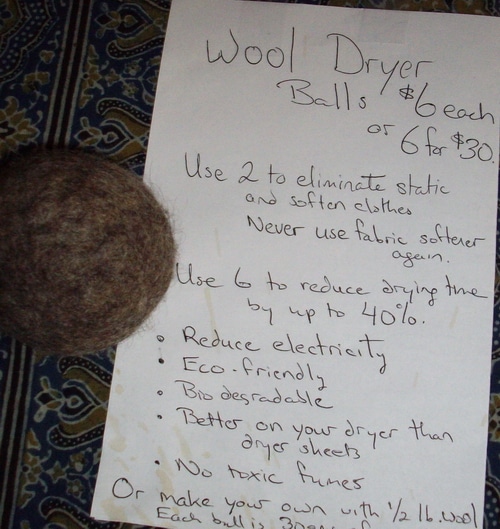
4. Wool dryer balls remove odors from your clothing
Chemical dryer sheets add a chemical scent to your clothing, masking odors and polluting indoor air. Natural wool dryer balls absorb odors from your clothing, leaving it smelling fresh, without the pollution or chemical risks to your health. They are naturally anti-bacterial.
You can increase the odor removal by adding a few drops of essential oils to your dryer balls. Oils like tea tree, lavender, lemongrass, and peppermint will permeate the wool and slowly release into your clothing during drying. Using essential oils for scent, in this manner, is also perfectly safe if you have indoor pets as all dryers are vented to the outdoors. Essential oil dryer balls also have an anti-bacterial effect, in addition to smelling amazing.
5. Wool dryer balls last for years with regular use
Plastic dryer pods will become brittle and break down with constant use. As they off-gas into your house with their toxic fumes they are breaking down one layer of molecules at a time. This will shorten the life of your dryer, too. Wool dryer balls, on the other hand, will stay firmly felted with constant use. When you want to freshen them, you just add them to a wash load and dry them again in your dryer.
With regular use, you don’t need to worry about moth damage to them, but if you are storing them for the summer because you’re switching to line drying, you can put them in a cloth bag for storage and firmly close to exclude insects. They will last for years.
6. Wool dryer balls break down static energy in your clothing. Wool balances the electrons in your textiles
Those dryer sheets contain silicone which coats your dryer and your clothing with an invisible film that can damage your dryer and prevents your clothing from naturally absorbing water. That’s a bad thing for diapers, towels, socks, and t-shirts. The silicone is how they reduce static in your clothes. Liquid fabric softeners do that same thing using silicone. The dryer pods are also made from a composite of silicone and plastic, so they are not a healthy alternative to the dryer sheets.
Natural Wool dryer balls break the static energy, naturally, because wool is naturally anti-static. Static in your clothing actually robs you of energy. Switch to wearing natural clothing and get the polyesters out of your wardrobe (that’s another post) — and you will have more energy for doing the things you love.
7. Wool dryer balls are beautiful and make you happy when you take them out of the dryer, with your clean laundry.
If you’re happy, you have more energy to do mundane tasks, like folding towels or diapers, so its a win-win proposition. Whether they are made from natural colored wools or naturally dyed wool, they are attractive and compel you to touch them, squeeze them and even play with them. They’re balls, after-all, not ugly, blue thorny pods.
8. When not in use as a laundry additive, wool dryer balls are fun to play with
My beautiful granddaughter visited me this weekend, and you can see how compelling the dryer balls were.
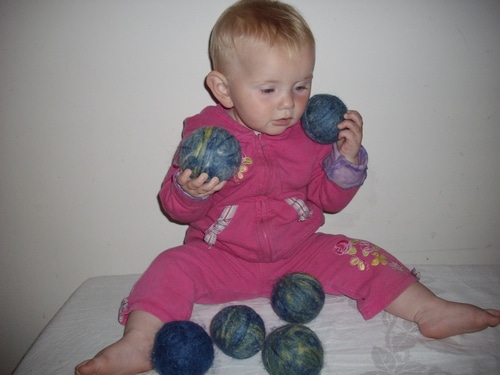
9. Using wool dryer balls will save you money, and time and improve your indoor air quality
Have I convinced you yet, to spend the next afternoon learning to felt your own wool dryer balls using up wool from your stash? It takes only a couple of hours to felt 6 wool dryer balls and that will save your wallet, and give you more time and energy for doing what you love.
If you need wool to make these, look for a local farmer that might have natural wool roving available, in natural white, grey, and brown. A half pound of wool roving will make 6 dryer balls. They’ll be happy to help you out with this great project.
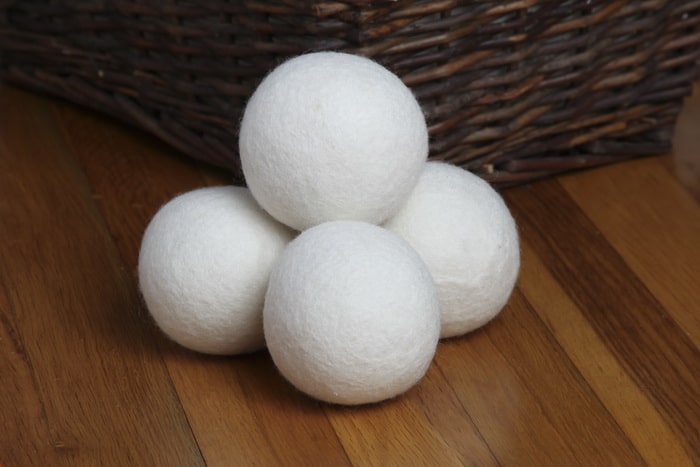
Handmade Wool Dryer Balls
You need:
1/2 pound of wool from sheep that will felt
Make sure its wool fleece from sheep, you don’t want llama, alpaca, mohair, angora or silk. These other types of wool will not stay firmly felted and will make your clothes linty. The best wool is at least 4 inches long and comes from long wool breeds like Romney or Lincoln which don’t pill as badly as merino, but you can use merino if that’s all you have. It should be washed and carded or made into roving. See this tutorial on how to wash wool if you are starting from the fleece.
If you are starting with fleece you will need a way to fluff the wool, separate it into individual fibers that can be layered. You can use a drum carder or even a dog brush. The main thing is to separate the fibers so that the felted wool has a smooth surface, rather than clumps of wool locks. Layer your prepared fiber samples until you have a large bundle and then gently pull out into a roving.
A bar of natural soap
Although you can use detergent for this project, the detergent will denature the proteins in your skin and it’s harmful. Instead, I use natural soap, most bars of soap that you buy in the store are made from detergent, so beware. Find a bar of natural soap because your hands will be in it for about an hour, and you want it to be safe and non-toxic.
Both hot and cold water
You actually don’t need a lot of water, just enough to dampen the wool balls. I put two, 2-liter glass bowls in the sink. One with hot water and one with cold.
A playful nature
Yes, you are going to play with soap and water for about an hour. If playfulness doesn’t come naturally to you anymore, I’d recommend doing this with a younger friend. It’s amazing how working with someone younger — even if its only younger in attitude — makes creating homemade wool dryer balls really fun.
How to Do It:
To begin you want to wrap a ball of wool
This is just like winding up yarn into a ball. You want to wrap tightly to make a solid core. Start by going around North to South to North and then turn the ball to go around West to East to West. Turn the ball again, and continue this way until the balls are about 1/3rd bigger than the finished size that you want.
We used about 45 to 50 grams of wool per ball. You want to make 6 balls about navel orange size, for optimum wool dryer ball use. They will felt down to tennis ball size when you are done.

Once you are ready, dampen the outside of one wool ball
I do this by wetting my fingers into the bowl of hot water and then splashing the outside of the ball. Don’t immerse the ball yet. First, you are going to felt the outside of the ball until you can no longer pinch up any individual fibers.
Rub your wet fingers into your natural soap and begin to rub the ball of wool gently
Be careful not to lift any loose fibers off the ball. Stroke in the direction that the fiber is laying. Keep dampening your ball, soaping your fingers and stroking the wool in the direction that it lays, while rotating the ball in your hands. If the fibers are lifting, try squeezing the wetted ball in both hands a few times to get the fibers firmly in place. Once the fibers are no longer lifting off the ball, you can start rubbing more vigorously with soapy palms. If it doesn’t seem to be felting then wet the ball a bit more.
The fibers will tighten down and your ball may become lopsided
Correct the shape by squeezing and rolling in several directions to keep your ball in the round shape. Like when you made playdough balls, you roll it in your palms or against the counter to make sure the shape is right.
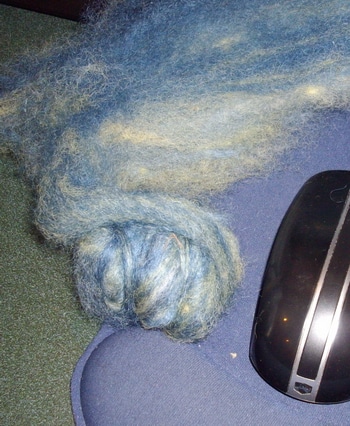
Immerse the balls into hot water
Once you can no longer pinch up any fibers from the surface of the ball, you are ready to immerse the ball into hot water, squeeze it out, and immerse in cold water. Squeeze out and immerse again in hot water. Do this 25 times. The ball with firm up and lose a third of its size.
You’re almost finished.
Remove the extra water
Squeeze the excess water from the ball and throw it into the sink, or the bathtub. Or place a towel on your counter and use that. You want to throw it hard onto the surface. It will splash so take that into consideration and use a place you don’t mind getting wet with soapy water. Do this 20 times. Correct the shape again and you’re done.
Repeat this process until you’ve felted 6 balls
Wring out the excess water from your 6 felted wool dryer balls and put them in your washer on the last spin cycle. You can air dry them now or just put them in your next dryer load and start reaping the benefits.
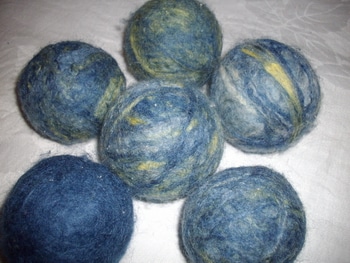
But if you want to have fun and save money, make your own with a friend. I hope you found this tutorial on making natural wool dryer balls helpful.
Other Natural Cleaning Ideas from Joybilee Farm
11 Ways to Bring Natural Cleaning into Your Home
Homemade All-Purpose Cleaning Spray with Whole Herbs
Article originally posted on June 27, 2011; Updated January 9, 2020.


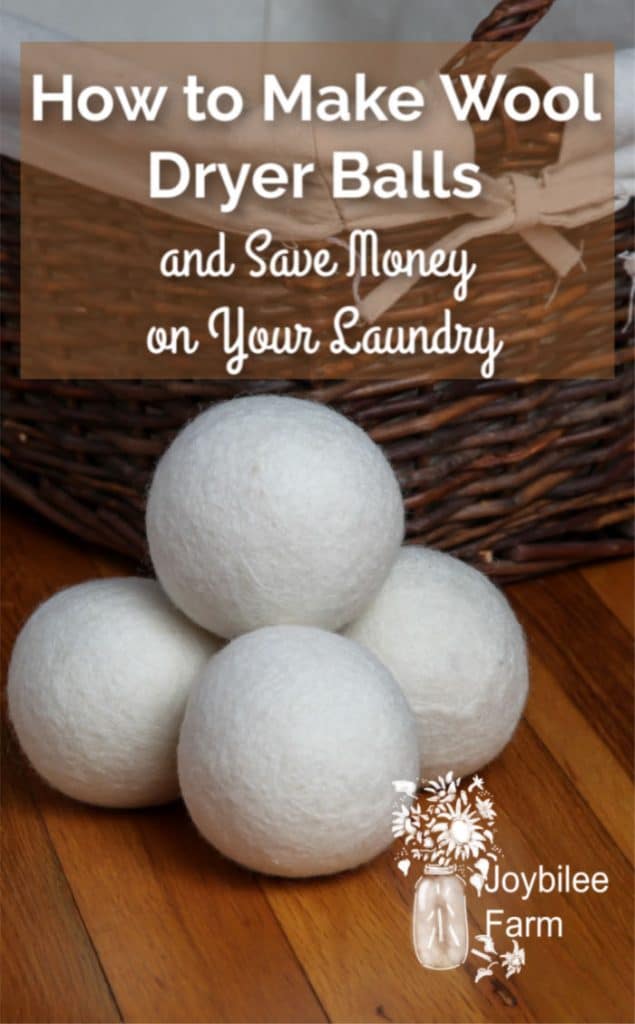

I have never had any issues with alpaca dryer balls. I love them! I make both since I have alpacas and a friend has sheep. I do felt the alpaca dryer balls very well though!
https://joybileefarm.com/fiberarts-supplies/
Do you have the roving wool available? I didn’t see it on your Farm page. Thank you.
we have not had that problem felting with alpaca?